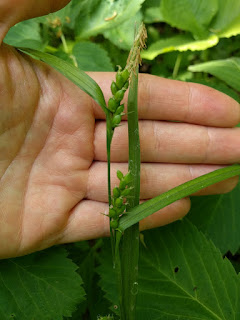Even with my eyes on the ground, the Virginia Creeper (Parthenocissus quinquefolia) made it tough to spot the baby White-tailed Deer which hid among the forbs.
My co-worker Andrew spotted this white flowered Wild Geranium (Geranium maculatum). Typically the flowers are pink to mauve. I had never seen a white bloom before.
The very broad leaves of White Bear Sedge (Carex albursina) paired with the whitish bases of the leaf sheaths make for easy identification.
On the other end of the spectrum, at least by name, Narrow-leaved Sedge (Carex grisea) was a new one for me. Also known as Narrow-leaved Sedge, Carex amphibola is quite similar with differences lying in the cross-section shape and length:width ratio.
I'm early on this next sedge, Muskingum Sedge (Carex muskingumensis), but I think I can be confident in the ID at this stage based on the habitat (moist vernal pool depression in this case) and the long, pointed perigynia with the terminal spike having an 'elm-like' kink to it. I'll have to check back later in the season to be sure. I found Muskingum Sedge growing in LaSalle Woods last year at the Ojibway Bioblitz, photos (of mature fruits) are shown in the post here (about halfway down).
A shot of one of the plants in full.
After the two of us stared at this flower-less plant for a moment, it became apparent that we were looking at Purple Joe Pye Weed (Eutrochium purpureum), a rarity that resembles the more common Spotted Joe Pye Weed (E. maculatum) but grows in slightly drier and more shaded habitats. The earlier typically has 3-4 leaves in a whorl on the stem whereas the latter has 4-5.
Always a good indicator that you're in nice habitat, Canada Waterleaf (Hydrophyllum canadense).
Good stuff indeed!
That afternoon I had to stop by a woodlot in Chatham-Kent for a few surveys. I was impressed by the 'photosphere' effect my phone has...you essentially shoot photos in every direction, and while the stitching is a bit blurred, you really get a cool 3D effect. I was trying to do some of the large Sycamore and American Beech justice. I think I saw one of the nicest American Beech I've ever seen, the thing was a flawless monster, perfect crown probably the largest tree in the woodlot, no signs of Beech Bark Disease and straight as an arrow. I didn't have my DBH (diameter at breast height) measuring tape on me but I suspect it would be 120-130 cm DBH.
And as luck would have it, Pawpaw (Asimina triloba) was in bloom. I've got to find a spot in the U.S. to try this edible delicacy, Ontario-cultivated fruits are hard to come by. It has a mango-banana-citrus type taste. If you're ever at the Ojibway Nature Centre in Windsor, there is a very large specimen growing beside the parking lot.





























































